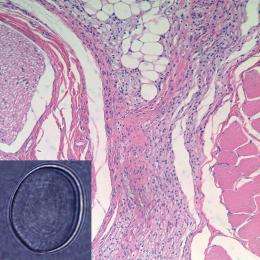Long-lasting nerve block could change pain management

(PhysOrg.com) -- Harvard researchers at Children’s Hospital Boston have developed a slow-release anesthetic drug-delivery system that could potentially revolutionize treatment of pain during and after surgery, and may also have a large impact on chronic pain management.
In work funded by the National Institutes of Health (NIH), they used specially designed fat-based particles called liposomes to package saxitoxin, a potent anesthetic, and produced long-lasting local anesthesia in rats without apparent toxicity to nerve or muscle cells.
The research will be published online during the week of April 13-17 by the Proceedings of the National Academy of Sciences.
“The idea was to have a single injection that could produce a nerve block lasting days, weeks, maybe even months,” explains Daniel Kohane of the Division of Critical Care Medicine in the Department of Anesthesiology at Children’s, the report’s senior author, and associate professor of anesthesia at Harvard Medical School. “It would be useful for conditions like chronic pain where, rather than use narcotics, which are systemic and pose a risk of addiction, you could just put that piece of the body to sleep, so to speak.”
Previous attempts to develop slow-release anesthetics have not been successful because of the tendency for conventional anesthetics to cause toxicity to surrounding tissue. Indeed, drug-packaging materials have themselves been shown to cause tissue damage. Now, Kohane and colleagues report that if saxitoxin is packaged within liposomes, it is able to block nerve transmission of pain without causing significant nerve or muscle damage.
In lab experiments, the researchers evaluated various formulations - various types of liposomes containing saxitoxin with or without dexamethasone, a potent steroid known to augment the action of encapsulated anesthetics. The best liposomes produced nerve blocks lasting two days if they contained saxitoxin alone and seven days if combined with dexamethasone.
Cell culture experiments and tissue analysis confirmed that the formulations were not toxic to muscle or nerve cells. Furthermore, when the team examined expression of four genes known to be associated with nerve injury, they found no up-regulation.
“If these long-acting, low-toxicity formulations of local anesthetics are shown to be effective in humans, they could have a major impact on the treatment of acute and chronic pain,” says Alison Cole of the NIH’s National Institute of General Medical Sciences, which partially funded the work. “This slow-release technology may also have broader applications in drug delivery for the treatment of a variety of diseases.”
Kohane is currently optimizing the formulation to make it last even longer, while avoiding local and systemic toxicity. “It is conceivable we could have a formulation that is suitable for clinical trials before too long,” he says.
Hila Epstein-Barash, a research fellow in anesthesia at Children’s Hospital, was first author on the paper.
Provided by Harvard University (news : web)
















